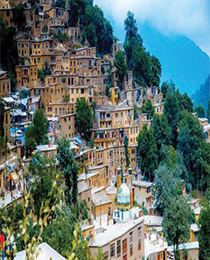Masuleh
One of the most picturesque locations in the Gilan province, along the Silk Route and the steep mountainside village that filled with lush greenery is called Masuleh Village. It is a city in and the capital of Sardar-e Jangal District, in Fuman County. Houses of this village which soar up high into billowing mist, layered and built as high as possible due to the tough living conditions on the lower ground. Stacking the houses high makes living here far easier for its inhabitants, who are safe from weather such as flooding and gives visitors a different experience away from the rush of Iran’s bigger cities. Notable for its traditional wooden buildings, clustered on the northern slopes of the valley, this village is registered as National Cultural and Natural Heritage in Iran, one of the sites of the UNESCO. The village is rich in tangible and intangible heritage. The surrounding mountains provide many opportunities for trekking, climbing and other activities.

History
In 1006 AD, some 6 km (3.7 miles) northwest from the modern town, the village was a thriving commercial spot for the ironworks industry trade and home to hundreds of families, who lived in the stacked houses that have become synonymous with the town. But the scenic setting suffered a tragic fate. A deadly plague epidemic, attacks from neighbouring villages and a huge earthquake led people to rehouse several kilometres away, reconstructing their original home.
Historical names for the city include Masalar and Khortab. The so-called ‘Old Masuleh’ now sits as an ancient site consisting of empty land with strewn rocks, while around 180 families live in the new town. Despite its tragic origins, the new village, built after the plague in 1565, has retained the charm of its ancient predecessor. It is said ‘the yard of the building above is the roof of the building below’, as houses are interconnected and form the pathway to climb even higher into the hill village
Masuleh Achitecture
The buildings have been built into the mountain and are interconnected. Front yards and roofs both serve as pedestrian areas similar to streets. The rare architecture of village is popularly known as “The yard of the building above is the roof of the building below”. Houses are mostly two stories (first floor and ‘ground’ floor) made of adobe, rods and bole. A small living room, guest room, hall, toilet, and balcony are usually found on first floor. Closets, barns and stables are located on the floor below, which are connected to the upper floor by several narrow steps inside the house.
Traditional dishes of Masuleh
This region is great for vegetarians as you can sample mirzeh ghasemi, a regional specialty of smoked aubergines which is burnt over hot coals – the aubergine is then fried with olive oil, garlic and tomatoes that is eaten with bread. Also, you can try ash-e doogh (yoghurt soup) which is another variation of ash-e reshte (noodle soup). The soup is full of vegetables like spinach and sometimes peas. It contains pulses such as chickpeas, plenty of herbs, such as coriander, parsley, mint and rice. Aswell as, there is asali halva (honey halva) and khoshk halva (dry halva), which is made with rice flour rather than semolina. Honey is used as its sweetener, instead of sugar.
The best time to visit
Summer is a popular time to visit the village, as the northern temperatures of country are a lot cooler than the rest of the country. It can get busy at this time; though, you can choose to stay overnight or hike in the surrounding mountains. Alternatively, winter is a good option with fewer visitors around. Temperatures drop to around 10°C then, but still provide a picturesque setting as the rooftops are often layered in snow.